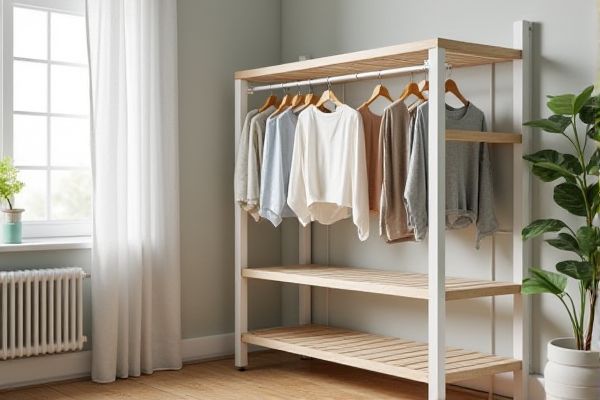
Pull-down drying racks offer space-saving convenience by folding neatly against the wall when not in use, ideal for small rooms or laundry areas, while accordion drying racks provide flexible, expandable drying space that adjusts to varying amounts of laundry. Discover which drying rack best suits Your needs and enhances your home's drying efficiency by reading the rest of the article.
Table of Comparison
| Feature | Pull-down Drying Rack | Accordion Drying Rack |
|---|---|---|
| Design | Wall-mounted, lowers down for drying, space-saving | Expandable, folds flat when not in use, freestanding or wall-mounted |
| Space Efficiency | Highly efficient, ideal for small spaces | Moderate efficiency, requires some floor or wall space |
| Capacity | Medium to large capacity depending on size | Variable, depends on expansion size |
| Installation | Permanent mounting required | Usually freestanding or easy wall mounting |
| Portability | Fixed installation, not portable | Portable when folded, easy to move and store |
| Material | Metal or wood with durable finishes | Metal, wood, or plastic options available |
| Best Use | Indoor drying in compact laundry rooms | Flexible use indoors or outdoors |
Introduction to Drying Rack Types
Pull-down drying racks are wall-mounted units that extend downward, saving floor space and providing multiple bars for efficient air-drying of clothes. Accordion drying racks feature a foldable, expandable design similar to an accordion, allowing compact storage and adjustable drying capacity. Both types cater to different space constraints and drying needs, with pull-down racks excelling in small rooms and accordion racks offering flexibility and portability.
What Is a Pull-Down Drying Rack?
A pull-down drying rack is a wall-mounted laundry solution designed to maximize space by allowing users to lower the rack for drying clothes and then lift it back up when not in use. It typically features multiple bars or rods that extend horizontally, providing ample room for hanging garments, towels, or delicates. This type of drying rack is ideal for small spaces, as it combines convenience with efficient use of vertical wall area.
What Is an Accordion Drying Rack?
An accordion drying rack is a space-saving laundry accessory designed with foldable, pleated panels that expand and contract like an accordion, providing adjustable drying space. Unlike pull-down drying racks that typically mount on walls and require vertical pulling to unfold, accordion racks can be freestanding or wall-mounted, allowing versatile placement and easy storage. Their collapsible structure offers enhanced portability and flexibility for drying clothes in various indoor or outdoor settings.
Space Efficiency Comparison
Pull-down drying racks maximize space efficiency by retracting flat against the wall when not in use, making them ideal for small laundry rooms or tight spaces. Accordion drying racks expand outward with adjustable arms, offering flexible drying capacity but require more wall clearance and can protrude into the room. For compact areas, pull-down racks provide a streamlined storage solution, while accordion racks suit spaces where variable drying space is needed without compromising wall space.
Installation and Setup Differences
Pull-down drying racks require mounting onto a wall or ceiling, utilizing sturdy brackets to support the weight of wet clothes and often need professional installation for secure setup. Accordion drying racks, typically freestanding or wall-mounted with simpler brackets, offer quick and easy assembly without specialized tools, making them more user-friendly for immediate use. The pull-down design saves floor space by retracting when not in use, while accordion racks fold flat against the wall but may take up more room when extended.
Capacity and Weight Limitations
Pull-down drying racks typically offer higher capacity with multiple rods designed to hold heavier loads, making them suitable for drying large laundry batches including towels and bedding. Accordion drying racks, while space-saving, usually have lower weight limits and fewer bars, restricting their use to lighter garments or smaller loads. Choosing between them depends on balancing space constraints against drying capacity and the weight of items.
Durability and Material Considerations
Pull-down drying racks are typically constructed with sturdy aluminum or stainless steel frames, offering enhanced durability and resistance to rust, making them ideal for long-term use in humid environments. Accordion drying racks often employ lightweight wood or plastic materials that may be less durable but provide portability and ease of storage. Your choice should consider the intended usage frequency and environmental exposure to ensure the selected rack's material withstands wear and moisture effectively.
Design and Aesthetic Appeal
Pull-down drying racks feature a sleek, modern design that integrates seamlessly into walls or cabinetry, offering a minimalist aesthetic ideal for contemporary homes. Accordion drying racks provide a more traditional, decorative look with their expandable, folding structure that adds charm and visual interest to laundry spaces. Both designs maximize functionality while catering to different style preferences, balancing practicality with visual appeal.
User Convenience and Accessibility
Pull-down drying racks offer superior user convenience by allowing easy access at different heights, making them ideal for users with limited mobility or small spaces. Accordion drying racks fold flat against the wall, providing a compact storage solution but may require more effort to fully extend and retract. Your choice depends on whether you prioritize effortless accessibility or maximizing available space with a simple folding mechanism.
Which Drying Rack Is Best for Your Needs?
Pull-down drying racks save space by mounting on walls and folding flat when not in use, making them ideal for small rooms or apartments. Accordion drying racks offer adjustable width and lightweight portability, suitable for flexible drying areas and frequent relocation. Choosing between the two depends on your available space, drying quantity, and preference for permanence versus mobility.
 homyna.com
homyna.com